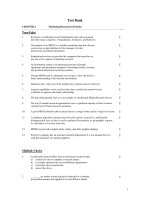Lecture Marketing research (12th edition) - Chapter 25: New age strategies
Bạn đang xem bản rút gọn của tài liệu. Xem và tải ngay bản đầy đủ của tài liệu tại đây (1.08 MB, 30 trang )
1
Marketing Research
Aaker, Kumar,
Leone and Day
Twelfth Edition
Instructor’s
2
Chapter Twentyfive
New Age Strategies
/
Marketing Research 12th Edition
3
The Need for Databases
To test a program prior to rolling it out:
▫ Define your target group
▫ Go into your database
▫ Create a matched set
▫ Expose the test variable
▫ Minimize other marketing efforts while the test is going on
▫ Allow test program enough time to work
▫ Measure results by comparing the two groups’ sales
▫ Take action. If test results warrant going ahead, then
▫ Implement it
/
Marketing Research 12th Edition
4
Elements of a Database
/
Marketing Research 12th Edition
5
Ways to Gather Consumer Data
/
•
Rebate Cards
•
Suggestion Cards
•
Warranty Registration Cards
•
Free Subscription Offer Cards
•
Directly Ask Consumers
Marketing Research 12th Edition
6
Ways to Gather Consumer Data (Cont.)
Guerilla Tactics
/
•
Get the product right
•
Use lowtech targeting and creative thinking
•
Use other people’s data (OPD) first
•
Buy new media
Marketing Research 12th Edition
7
Types of Databases
•
•
•
Active customers
Inactive customers
Inquiries
Modeling customers serves to:
/
▫
Identify most typical customers and so become more effective in
prospecting.
▫
Identify best customers to prospect
▫
Identify niche markets to add to the marketing universe.
▫
Develop more effective marketing tools (materials and media).
Marketing Research 12th Edition
8
Benefits of Database Marketing
/
▫
Customers are easier to retain than acquire
▫
Determine their “lifetime value” to decide whether or not to encourage
greater lifetime duration
▫
Develop relationships with customers across a family of related
products and services
Marketing Research 12th Edition
9
ECommerce
•
Ecommerce influence
▫ The impact of the ‘Net on purchases made entirely off
line’
•
Ecommerce ordering
▫ Captures the orders that are placed online but paid for
later via telephone or instore
•
Ecommerce buying
▫ Combines ordering and paying online
/
Marketing Research 12th Edition
10
ECommerce (Contd.)
2011 Holiday Season to Date vs. Corresponding Days* in 2010
/
Marketing Research 12th Edition
11
ECommerce (Contd.)
/
Marketing Research 12th Edition
12
ECommerce (Contd.)
•
/
Retailer responses to ecommerce are:
▫
Selective price discounts
▫
Concentrating attention on late adopters of technology
▫
Creating and staging experiences
▫
Partially adapting the Internet into a hybrid system
Marketing Research 12th Edition
13
Future of ECommerce
•
Ecommerce will represent 8 percent of total U.S. retail sales in
2014.
•
Travel will remain the largest online retail category, growing from
$98 billion in 2009 to $144.7 billion in 2015.
•
General merchandise (all retail categories excluding auto, food
and beverage, and travel) will top $250 billion by 2014.
•
An increase in the number of women shoppers will contribute to
14 percent of jewelry sales moving online by 2010. Online sales of
health and beauty products will grow at an annual rate of 22
percent.
•
/
Twentynine percent of small appliance sales will migrate online
by the end of the decade as a generation that grew up with
Marketing Research 12th Edition
14
Mobile Marketing
•
Mobile marketing is an important application that is
poised to emerge as a medium that offers a quantifiable
reach, rich experience as well as targeted marketing
opportunities
Advantages of Mobile Marketing
/
Marketing Research 12th Edition
15
Mobile Marketing (Contd.)
•
•
Mobile marketing is being implemented as an
innovative way to extract maximum revenue from
each customer
Direct and Indirect values are measured by the
following indicators:
1.
2.
3.
4.
/
Customer Lifetime Value (CLV)
Customer Referral Value (CRV)
Customer Influence Value (CIV)
Customer Knowledge Value (CKV)
Marketing Research 12th Edition
16
Mobile Marketing (Contd.)
Potential development areas of mobile marketing research are:
/
Marketing Research 12th Edition
17
Social Marketing
•
•
The numbers of online social networks and
blogs are expanding at a feverish pace,
attracting consumers from a wide range of
demographic segments
Some of the popular social media channels:
1.
2.
3.
4.
/
Blogs
Social networks: such as Facebook, Myspace,
LinkedIn.
Content Communities: such as Youtube, Google
Video (video sharing), or Flickr (photo sharing).
Social Coupons: such as Groupon and Living Social
Marketing Research 12th Edition
18
Social Marketing (Contd.)
/
Marketing Research 12th Edition
19
Experiential Marketing
•
•
/
Experiential marketing connects customers and
brands in encounters designed to turn consumers
into advocates.
While experiential marketing may sound
synonymous with wordofmouth and event
marketing, in reality it is narrowly defined and
aimed at niche audiences, generating a higher
return on the investment.
Marketing Research 12th Edition
20
Relationship Marketing
Keys to Relationship Marketing:
•
•
•
/
Identify and build marketing databases of
present and potential purchasers.
Deliver differentiated messages to
targeted households.
Track the relationship to make media
expenditures more effective and more
measurable.
Marketing Research 12th Edition
21
Metrics to Manage Customer Loyalty
22
Developments in Relationship
Marketing
Customer lifetime value (CLV)
•
▫ Calculated as the sum of cumulated cash flows —
discounted using the Weighted Average Cost of
Capital (WACC) or discount rate — of a customer
over his or her entire lifetime with the company
•
Customer equity (CE)
▫ The total of the discounted lifetime values summed
over all of firm’s current and potential customers
/
Marketing Research 12th Edition
23
Customer Lifetime Value
24
Developments in Relationship Marketing
(Contd.)
•
Aggregatelevel approach
▫ CE framework can be used to:
/
Formulate firm/segment level strategies concerning
investments in acquisition, retention, and addon selling.
As a surrogate measure of the market worth of most firms
and for comparing competing firms.
Marketing Research 12th Edition
25
Developments in Relationship Marketing
(Contd.)
•
Disaggregatelevel approach
▫ CLVs of each customer can help to formulate customer
specific marketing strategies for:
/
Customer selection
Customer segmentation
Optimal resource allocation
Purchase sequence analysis
Targeting profitable prospects based on CLV
Marketing Research 12th Edition









